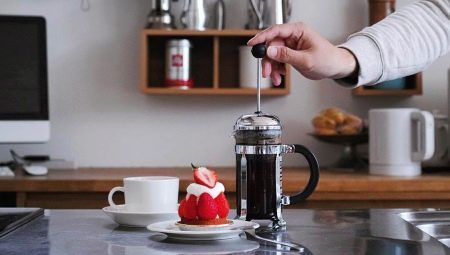The lack of a coffee machine is no reason to switch to a soluble drink instead of your favorite freshly brewed one. Buying a French press will not be a serious burden for the budget, but it will allow you to quickly and easily make coffee at home.
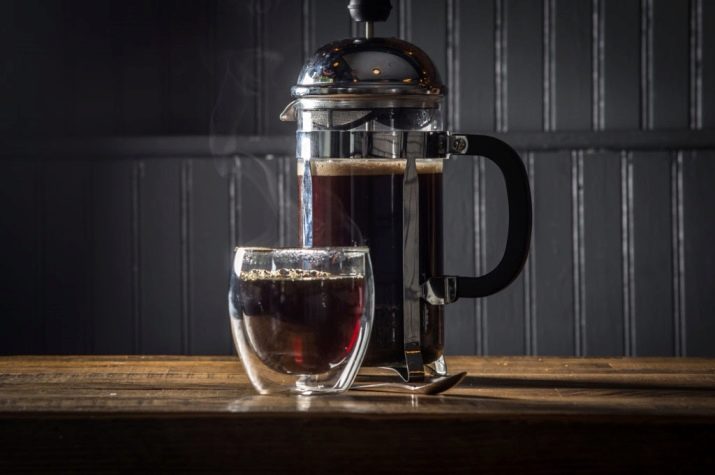
Origin history
The French press for coffee became known to the world in 1929. Thanks for this should Italian designers Attilio Kallimani and Giulio Monetawho not only invented this device, but also immediately patented it. Since the French company has become the industrial manufacturer of the piston design, which allows brewing coffee, the name indicates the country of origin. It happened in 1958.
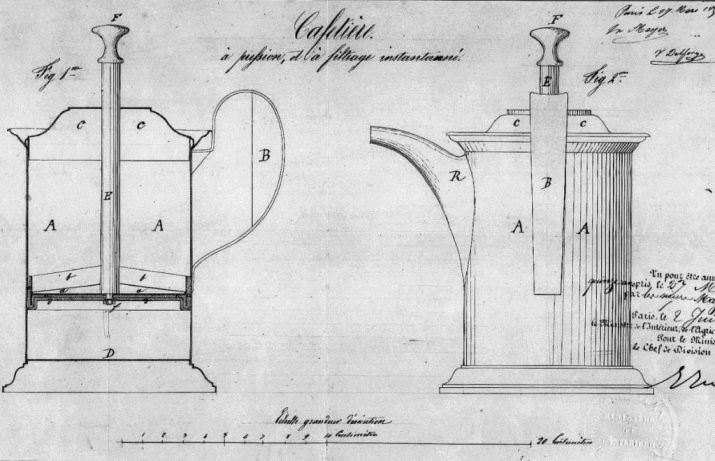
However, it’s important to add that The first version of the French press was introduced back in 1852. Unfortunately, the device was imperfect and did not stop the thick from getting into the mug. The new version, presented by Milanese designers, had a special mesh instead of a metal plate, acting as a filter. Thanks to the innovation, the liquid and the thick were separated, and therefore the drink turned out as it should be.
Over time, a safe handle was attached to the flask, as well as a base that prevented the surface from warming up.
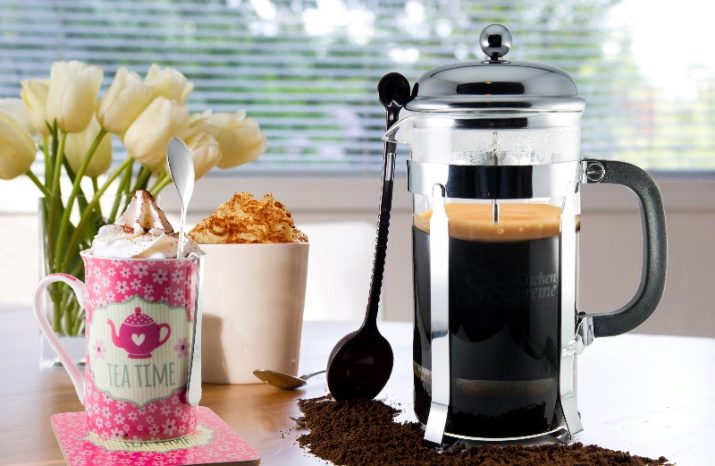
Description
The French press is a glass container, hermetically sealed with a lid, with a handle and a piston. The pin of the latter is fixed so as to pass through the cover on one side, and on the other hand it is convenient to place a filter made of steel mesh. After pouring ground coffee, it must be poured with hot water, and then press firmly on the piston handle.Thus, all the thick will go down, lingering in the filter, and the finished drink will remain in the flask. The brewing time for coffee can vary, and depending on this, the taste and saturation of the prepared drink will change. One of the main advantages of the French press is the ability to fully reveal the aroma of the drink and make the taste clean, devoid of any impurities. If you follow the instructions, you can guarantee the absence of bitterness and sourness, if they are not provided for by the variety of coffee.
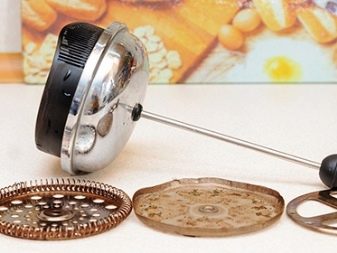
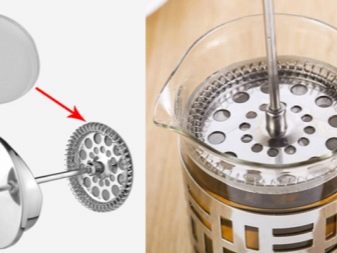
Comparison with a French press for tea
There is no particular difference between the presses for making coffee and tea. Outwardly, both devices cannot even be distinguished from each other - the same bulb with a handle and a piston. but presses are made of different materials and also use different filters. In addition, it is customary to choose small designs for a coffee drink, and those with a volume of 750 milliliters or more are suitable for tea.
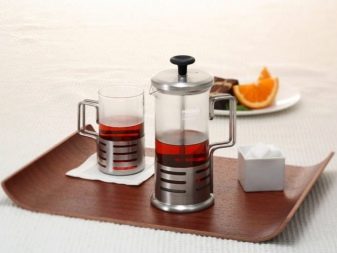
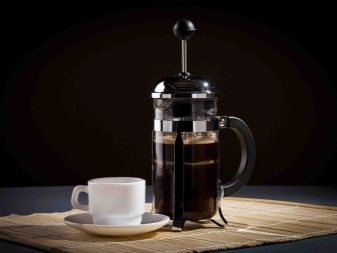
Model Overview
In general, professionals distinguish several varieties of French presses. The classic French press corresponds to the original design and has some drawbacks. Since the flask holds only a certain number of cups of coffee, if you want to make another drink, you will have to rinse the entire device, including the filter. In a situation with a large number of people who want to try a drink, certain problems arise. In addition, sometimes small particles still get into the liquid. Some companies are trying to improve their models and provide them with additional elements for the convenience of brewing coffee.
- If we consider the rating of models of a French press for making coffee, then the majority of experts recognize the device of the company as the best Bodum kenya. Its advantages include high quality, stylish design and the use of environmental materials that do not harm human health or nature. The TalleR brand presses perform quite well. The convenient spout of the flask made of heat-resistant glass allows you to pour the drink without leaving smudges.
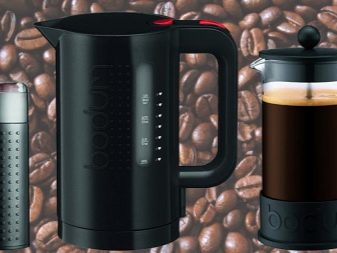
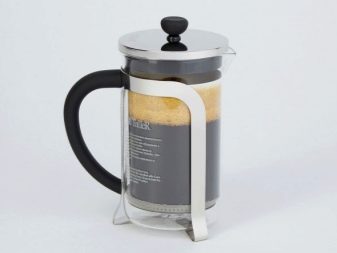
- French by German company Gipfel They look very modern and organically fit into many kitchen interiors. Most often, the flask is purchased immediately with mugs of the same brand. Inexpensive, yet proven French presses from the Vitesse brand are sold complete with mugs. Designs are made of high quality stainless steel and heat resistant glass. The advantage of this choice is the ability to wash the press in the dishwasher. Another good press manufacturer is Rondell.
The advantages of the models include the presence of a thermally insulated handle and a spare bulb sold in the kit.
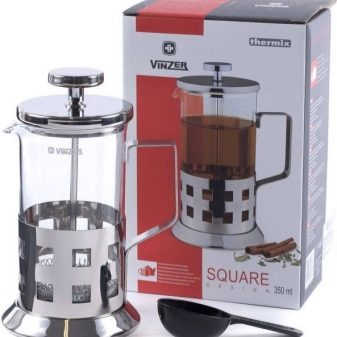

- Model Espro Press differs from the classical one by the presence of a double filter. A device developed by a Canadian company allows you to drink cleaner coffee without impurities.
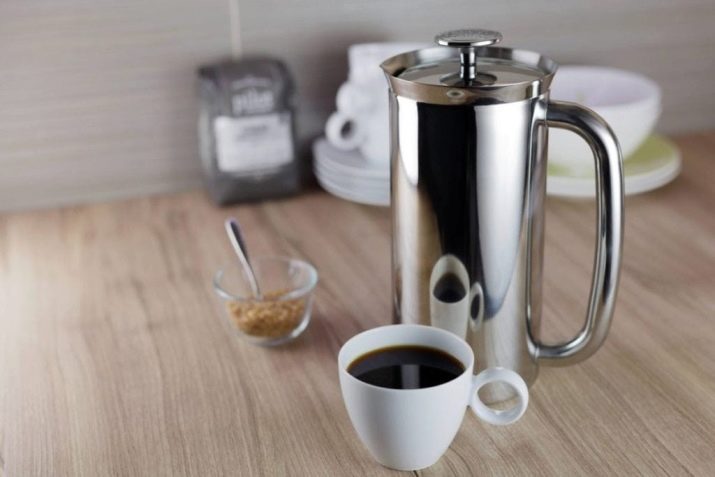
- American press is a design in which a small chamber, into which coffee is poured, is attached directly to the piston. The cooking technology in this case is different from the usual. A lightly soaked paper filter is laid out at the bottom of the cell where coffee is poured. The flask is filled with hot water, after which the piston is lowered so that the ground particles are only slightly moistened. After half a minute, the piston slowly begins to be pressed so that after only one minute it reaches the bottom. In general, the drink should be brewed from 3.5 to 4 minutes.
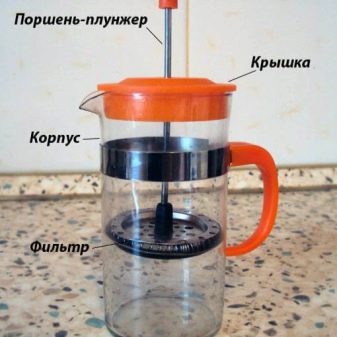
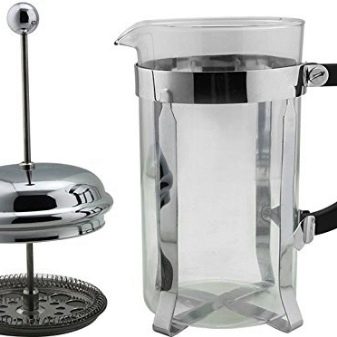
- Finally there is Model Rite Coffee Pressthe chamber of which is installed at the bottom of the flask made of ceramic or stainless steel. For convenience, an hourglass, acting as a timer, is attached to the side of the structure.
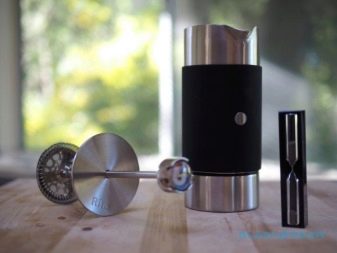
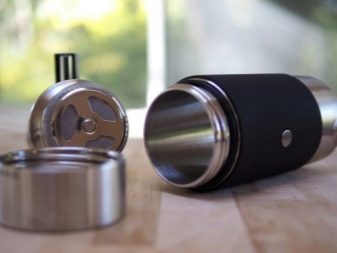
Features of choice
To choose a French press, several important factors must be considered. As for the material, there are several options: the flask can be made of glass, ceramic or stainless steel. Glass is most often used heat-resistant, but its durability leaves much to be desired. In addition, cheap models often can not cope with temperature extremes. It is recommended that you purchase the kit that contains the replacement flask, just in case.
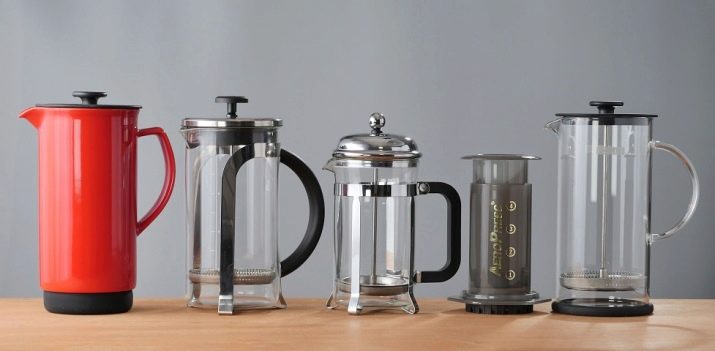
Ceramic and steel flasks are more durable, but complicate the cooking process a bit, since it is impossible to observe it. Nevertheless, the drink that is prepared in a french press made of ceramics is considered the most delicious. If possible, it is better to take a vessel with double walls that retain heat.
The choice of filter depends on the planned grinding: stainless steel can work with coarse and medium grinding, but the filter made of nylon is suitable for finer grinding powder.
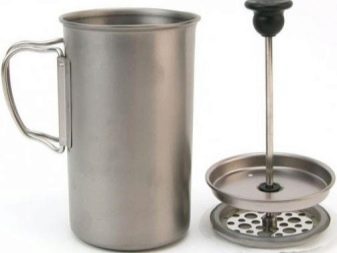
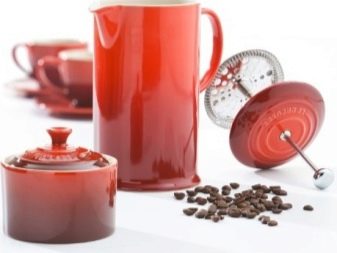
When buying, it would be nice to inspect the handle of a French press - parts made of bamboo or coated with polymer are considered ideal. In any case, it is important that it does not heat up. The base of the flask must be stable.
Experts do not advise buying cheap models, as they fail very quickly. There is no need to buy too expensive devices - as a rule, their high price is largely due to the reputed brand or unusual design. The middle category is just what you should focus on. Operation will be much more convenient if a press is purchased that can be disassembled and rinsed quietly, so this advantage is important. Studying information about the glass used, you should focus on the company Pyrex, which manufactures reliable heat-resistant glass.
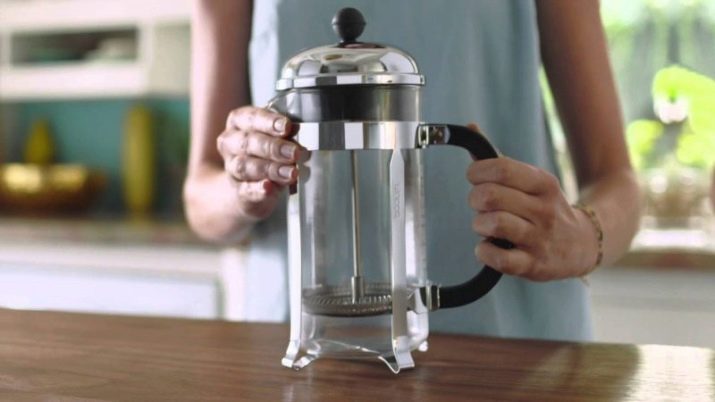
User's manual
To properly use the French press for coffee, it is enough to prepare ground coffee once according to the instructions, and then brew the drink in the same way. To implement the venture will require 17 grams of ground coffee, which is equivalent to three teaspoons with a slide, as well as 250 milliliters of clean drinking water. In no case should you take water from the tap. Water should be filtered. Ideally, bottled water should be purchased.
Besides, cooking is impossible without a kettle, a timer, and of the French press itself. Experts recommend choosing coarse coffee, which is visually easy to identify by the appearance of individual particles resembling granulated sugar.
It will be possible to make a tasty drink when purchasing a finely ground product, but in this case, forcing a piston with a filter will be too difficult.
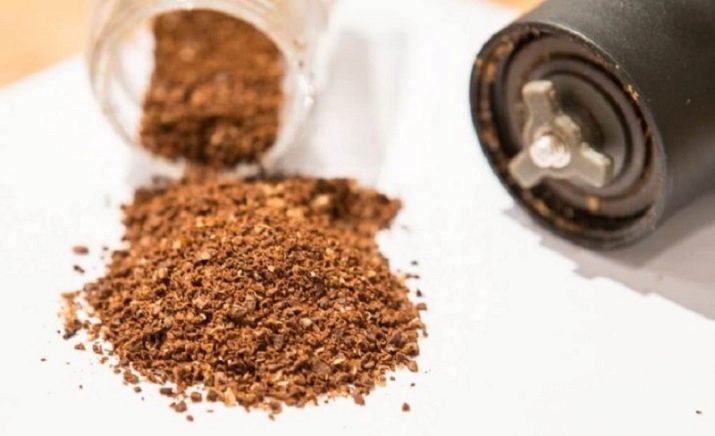
As a rule, 7 grams of coffee is taken per 100 milliliters of water, but depending on the variety, the taste of the drink can change, and therefore it is recommended to vary the ratio depending on your own feelings. If in doubt, you can simply pour coffee either to the level of the lowered filter, or to the mark of the start of the handle. Before brewing a drink, it is necessary to thoroughly rinse the French press and be sure to dry it, since a sealed vessel tends to retain odors.
In the kettle, the water is brought to a boil, after which a couple of minutes are waited until it cools. The temperature of the fluid used should be in the range of 90 to 95 degrees. At the next stage, ground coffee is poured into the container. Before this, experts recommend warming up the French press, pouring boiling water inside and shaking it lightly. Similarly, it is advised to do the same with the cup in which the drink will be served.

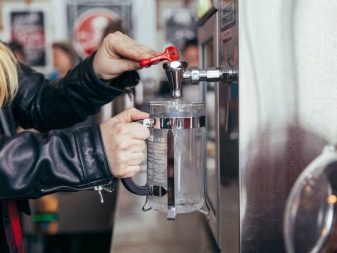
100 milliliters of liquid from a freshly boiled kettle is slowly poured into a French press, which already contains a coffee product. Water should completely hide all the coffee. The drink is mixed with an ordinary spoon and set aside for about one minute. Time is more convenient to track with a timer. Then the remaining water is carefully added, moreover, the foam should not be damaged. The French press closes and 3 minutes is detected using the timer.
Finally, the most important part of cooking takes place - the piston drops to the very bottom as accurately as possible. The movements should not be sharp or too strong - it is important that the piston runs smoothly. The finished drink is immediately poured into the prepared mug so as not to provoke a glut. It is worth mentioning that spices are added to coffee while it is still brewing. Varieties such as cardamom, ginger, cinnamon, nutmeg, or combinations thereof are popular.
As for the additional ingredients - milk, sweetener or alcohol, their addition is carried out already in the finished coffee.
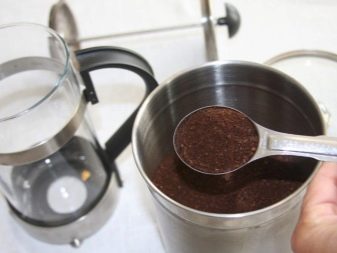
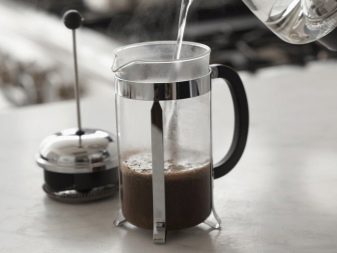
The used French press is washed every time after preparing the aromatic liquid. If you postpone this procedure, then a persistent smell may remain inside, which over time will become very unpleasant. It is important not only to wash the flask, but also the filter, both in the mesh and under it - it is in this complex area that the particles of the ground product often remain. From time to time it is recommended to disassemble the filter and clean all its parts separately.
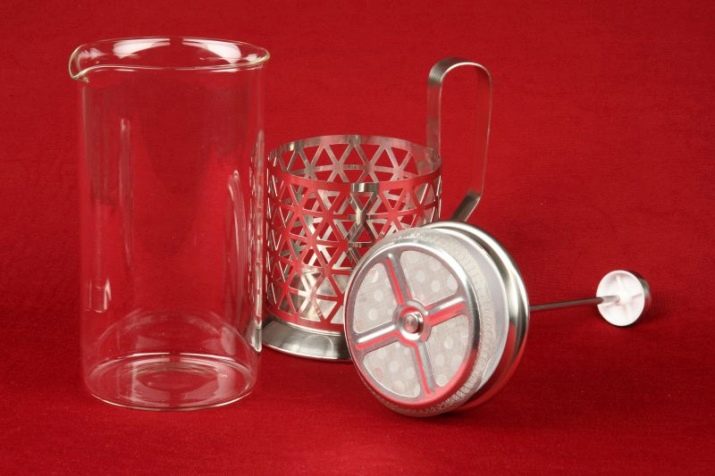
How to make coffee in a French press, see the video below.
